by Editor | Mar 30, 2015 | Food
By Elena del Valle
Photos by Gary Cox
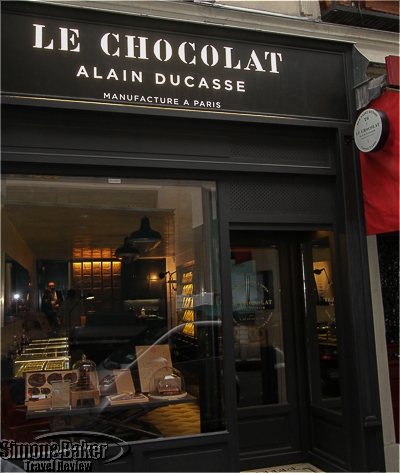
Le Chocolat storefront on Rue Saint-benoite
Paris, France is a city where many bakeries sell chocolates and specialized chocolate shops abound. Some shops sell handmade chocolates made onsite while others tout imported bonbons. Some vendors, especially in tourist areas, attract buyers with elaborate chocolate art and sculptures, sparsely stocked display cases, uniformed and gloved staff, and the high prices that might mean high quality, but don’t necessarily deliver on the implied promises.
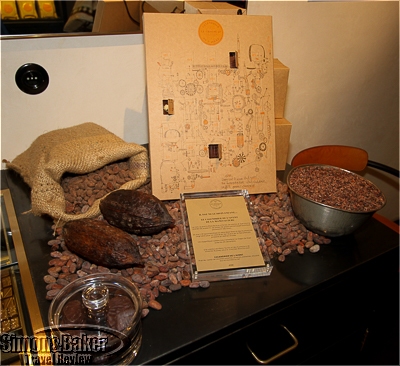
Inside the store there was information and a display of the raw ingredients for chocolate (click to enlarge)
With such a plethora of choices what makes one chocolate seller rise above the rest despite simple, some might say understated, wrapping and boxes? Chocolates, especially single source dark chocolate bars, made from scratch in the shop’s own factory with organic ingredients. At this newly opened shop there were no artificial or from frozen ingredients, flavor enhancers, additives or preservatives in the products. In December 2013 we featured the factory (see The art of making chocolate Alain Ducasse style in Paris).
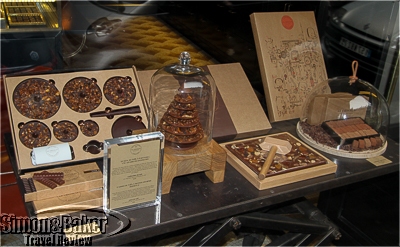
Specialty chocolate gift items in the window display
On our most recent visit to the City of Lights we discovered Le Chocolat Alain Ducasse’s new Left Bank location on a side street off the famed Boulevard Saint Germain (26, rue Saint-benoit, 75006, Paris, +33 01 45 48 87 89, http://www.lechocolat-alainducasse.com, contact@lechocolat-alainducasse.com). We returned often during our stay.
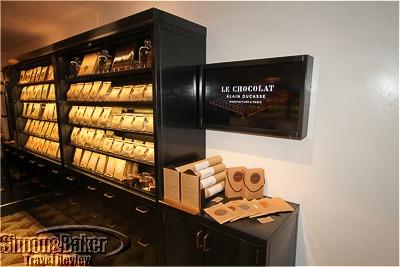
A video about the making of the chocolate ran on a screen (click to enlarge)

A chocolate spread and hot chocolate mix display (click to enlarge)
Opened in March 2014 the 30 square meter shop was owned by Alain Ducasse, he of the culinary empire. Despite the unobtrusive facade (we almost missed it on our first visit due to nearby construction) the shop was busy every time we were there. We were so distracted browsing the chocolate filled shelves and display cases on either side we almost missed the wall mounted television screen with presentations on the factory and manufacturing process, and the pretty original tiled floor.
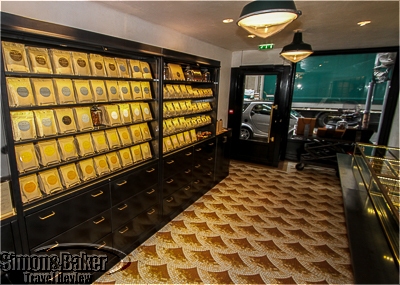
Note the chocolate bars on display and the historic tile floor (click to enlarge).

A glass covered display case housed a variety of chocolate covered bonbons (click to enlarge).
On sale in a tall wall case, in brown paper foil lined resealable bags, were 48 varieties of chocolate bars. The design on the bars, available in 100 percent (only one), 75 percent, 65 percent, and 45 percent, was by Pierre Tachon. On the opposite side of the shop, there were also 25 types of bonbons, dragées, roc’s, soveria candied fruits, chocolate chips and chocolate spread (in glass jars) all made at the city factory in the eleventh arrondisement.
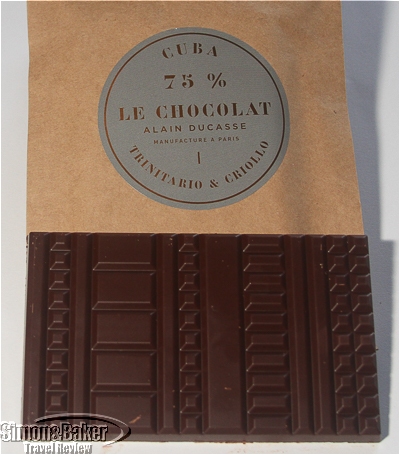
Chocolate made from Cuban Trinitario and Criollo beans
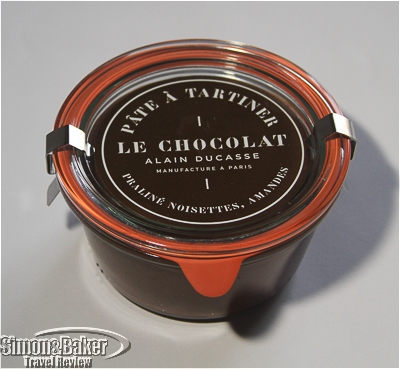
Chocolate and hazelnut spread
Under the careful supervision of the factory staff, the products were manufactured from cacao imported from small farms in 13 countries: Ecuador, Venezuela, Peru, Madagascar, Mexico, Granada, Sao Tome, Java, Dominican Republic, Trinidad, Vietnam, Cuba, and Brazil. To sweeten the brown paste the makers used organic non refined sugar. Italian artisan candied fruits were added to some bars including the muesli chocolate. The milk chocolate muesli chocolate bars, Mendiant Lacte Muesli 45 percent, quickly became my favorite item. Like the truffles and pralines they had a relatively short shelf life compared to the dark chocolate bars, but that was never a problem as they didn’t last long. I can’t wait to return to Paris to buy a stack.
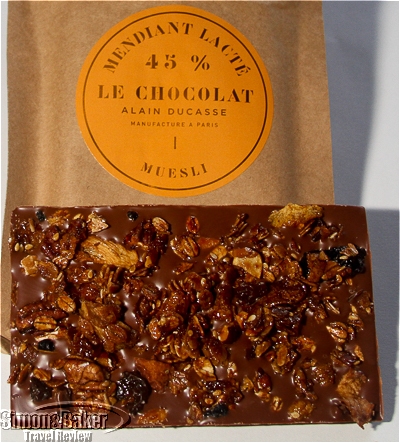
A favorite: milk chocolate with muesli
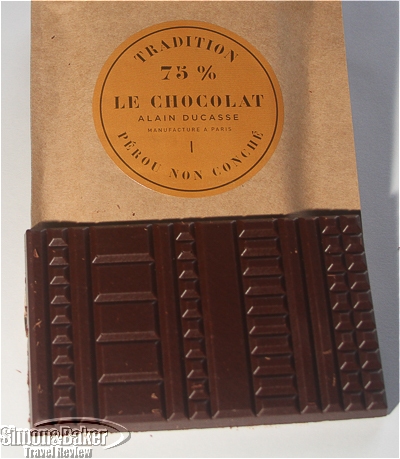
Peruvian chocolate that had not been conched
We sampled the chocolate spread, and a box each of truffles and praline chocolates. From the chocolate bars we had mostly plain dark chocolate varieties although the Fourree made with coconut and passion fruit filling was another favorite. The single source bars we tried were 75 percent dark chocolate Venezuela Porcelana Criollo (a favorite with a sweet and tart finish), Sao Tome Forastero Amelonado, Cuba Trinitario Criollo (satisfyingly dark without being too sharp), Tradition Perou Non Conche (a favorite from our previous tasting, it was slightly gritty yet rewarding), and Bresil Trinitario. The Brazilian had a dark flavor with hints of tobacco while the Sao Tome was tart with a touch of spice. The Brazilian and Cuban flavors were new and was the 100 percent Peruvian chocolate bar. We tried 100 percent Perou Trinitario, made exclusively from Peruvian cacao. It was sharp and bitter, an acquired taste.
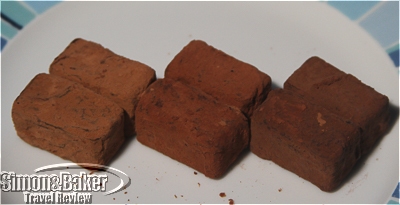
Various chocolate truffles coated with cocoa powder
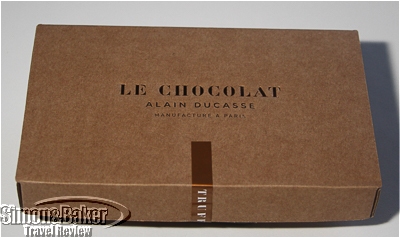
The truffles came in a cardboard box
Kudos to Alain Ducasse and Nicolas Berger, the passionate man behind the chocolate factory, for their artisanal chocolate products, in particular the single source dark chocolate bars (and muesli milk chocolate bars for milk chocolate fans) worthy of a detour.
by Editor | Mar 16, 2015 | Luxury Travel
Article and photos by Elena del Valle
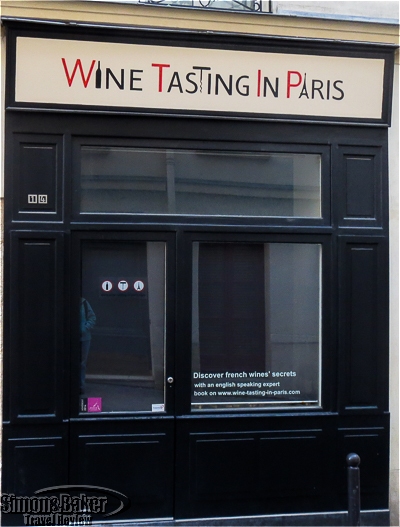
The entrance to Wine Tasting in Paris on an old cobblestone street
Understanding and appreciating wine is a personal and subjective experience, one I always feel the need to improve. Each time an opportunity presents itself for me to grow my knowledge and exposure to wines I jump on it. And what better place than Paris, France while I had time to spare? When I heard about a new program in English I was immediately interested. Hosted by Thierry Givone, a native of Burgundy, the French Wine Tour, a two hour hands on workshop was engaging and fun. Thanks to its central location I was able to walk there from my temporary Parisian home.
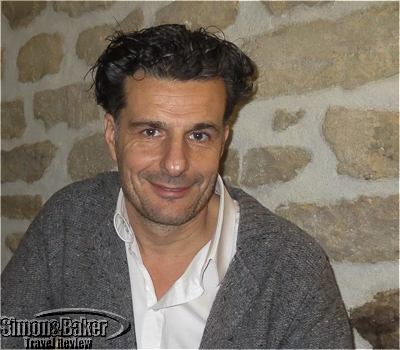
Thierry Givone, a native of Burgundy, hosted wine tasting workshops in English.
Following self introductions and a brief video presentation by our host, six of us, all Americans coincidentally (while Americans represent half of his clientele, many British, Canadians, Australians, and Europeans attend as well) tasted and discussed six wines ranging in retail price between 12 and 20 euros. They were, Champagne Brut Reserve from Thierry Massin; Sauvignon blanc Eclat de Silex, from Domaine Michaud, in Loire Valley 2013; Chardonnay Macon La Roche Vineuse from Domaine Merlin in Burgundy 2013; Pinot Noir Mercurey from Chateau de Santeney 2009; Bordeaux Chateau D’arcins Haut Medoc Cru Bourgeois 2011; and ORTAS, From Caves de Rasteaux, in Rhone Valley 2012.
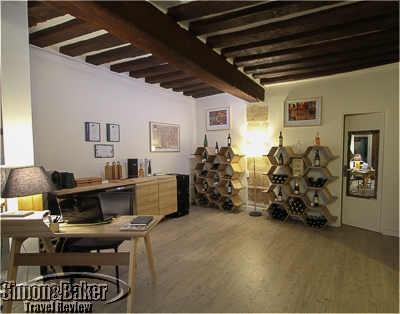
The main area of Wine Tasting in Paris (click to enlarge)
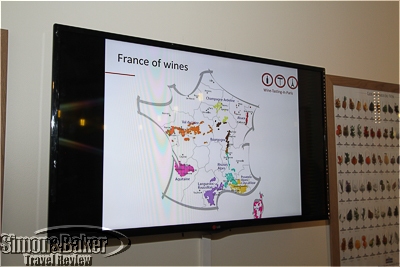
Givone relied on a flat screen television for his presentation.
“I hope the quality of my welcome, from the confirmation e-mail to the recommendation of what to do or where to go after the tasting,” said Givone when asked what makes his programs special in a city filled with wine and gourmet tasting possibilities. “Individual interaction, the fact that I created the company and I animate all tastings myself, with passion and involvement, when other companies just drive the business and hire free lance sommelier for the animation. The atmosphere of my space, in this nice street, with a small tasting room where people feel very well. I’ve tried to create a ‘tour’ with a good combination of global information, details, historical facts, fun facts, and personal experience, so that people have learned things and had a great moment.”
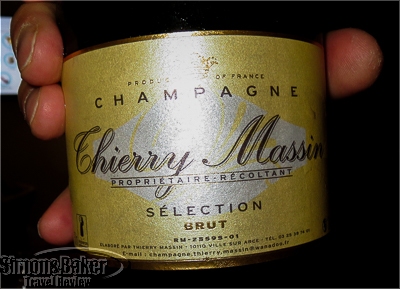
The champagne selection from Thierry Massin
Givone’s first job was as marketing manager in a French subsidiary of an American group. In 2013, he established Wine Tasting In Paris (14 Rue des boulangers, 75005 Paris, France, + 33 676 933 288, www.wine-tasting-in-paris.com, thierry@wine-tasting-in-paris.com) at another location. The course I attended took place in a 45 square meter two room space within a building that may date to the XVII century, near metro stations Cardinal-Lemoine and Jussieu. The cobble stoned street itself was already in existence in 1350.
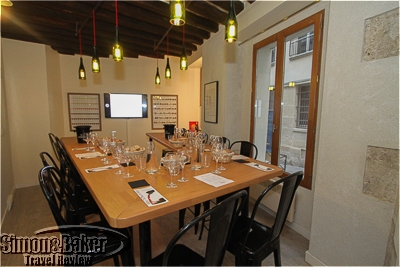
We spent most of the time at the table, watching the presentation and tasting wines. (click to enlarge)
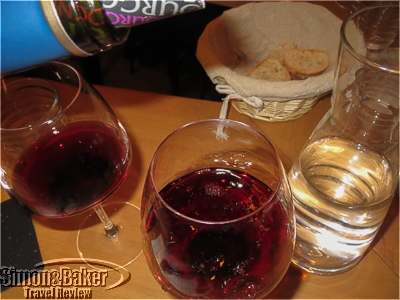
We each had wine glasses, bread and water within reach.
Givone, a fan of wines from his native Burgundy, rounded his wine education by spending time at Wine and Spirit Education Trust (WSET) at the Ecole du Vin in Paris, Wine School of Bordeaux, and Wine University of Cotes du Rhone. The way to taste was by looking, smelling and tasting a wine, he explained. He recommended that we smell the wine before swirling it in the glass to smell it a second time before tasting it.
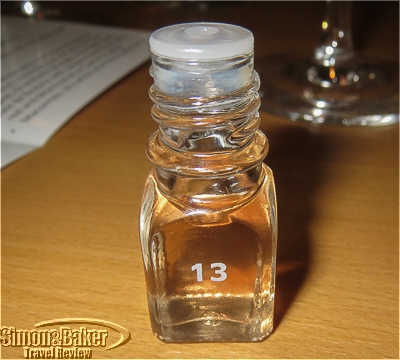
A smell aid we used to practice identifying scents
He relied on synthetic smell aids in an exercise designed to teach us to identify the range of flavors found in wines. They were flower, fruit, vegetable, earthy such as mushrooms and forest, spices like pepper and vanilla, wood, toasted aromas, mineral, balsamic, animal and chemical or foreign. He described the varied flavor zones of the tongue. We can taste sugar on the tip, acidity and salty flavors on the side and bitterness in the back, he explained.
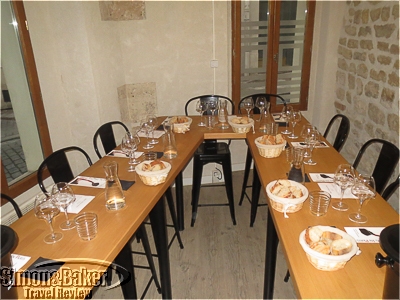
The custom made table allowed everyone to see the presenter.
The meeting room featured a modern design and wood furniture. The tasting table with a V shape was custom made according to his specifications to allow up to 12 guests a good view of the presenter and the large wall mounted television screen. At the same time, it allowed him to stay in the middle to pour of wine for each tasting course. We plucked pieces of sliced baguette from the bread filled baskets nearest each of us to cleanse our palates between wines. As the workshop ended several of us lingered and bought wines to take home and sample at leisure or with a meal.
by Editor | Mar 2, 2015 | Accomodations
By Elena del Valle
Photos by Gary Cox
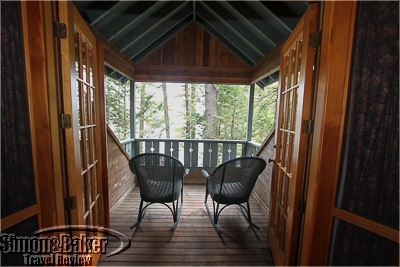
The balcony in the master bedroom in Firefly
We arrived at Migis Lodge on Sebago Lake, a property on the shores of Lake Sebago in Maine, a bit stressed following a week of tourist activities and a frustrating longer than necessary drive from Portland. The relaxed atmosphere at reception, the serenity of the wooded setting in the early stages of fall foliage color changes, and our comfortable three bedroom two bathroom suite in a stand alone wood building went a long went toward helping us unwind.
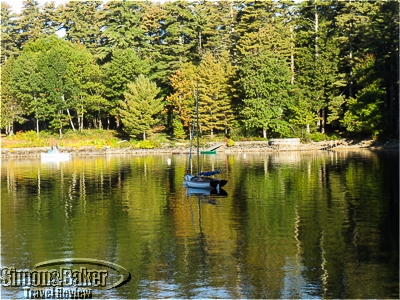
Fall colors were just reaching the shore of the lake when we visited Migis Lodge (click to enlarge)
It was especially soothing to look out onto the lake from the front porch or living room of our suite without any particular plans, activities or commitments. Knowing all our meals were included in the American Plan allowed us to relax and took the decision making out of our stay. Should the weather worsen, as the forecast indicated, dinner was steps away from our building. If it improved we had the option of exploring the region in search of the brightest and best autumn trails.
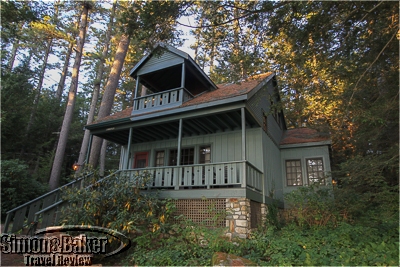
Firefly cabin at Migis
Five days later when we drove away, we were re-energized and ready to discover another part of Maine. Migis struck me as a wonderful place to reconnect with personal priorities, spend time with family and friends, for an artist retreat or a romantic getaway.

































